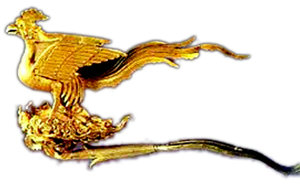Hairpins and hair clasps were everyday embellishments in old China. During the Ming (1368-1644) and Qing Dynasties (1644-1911), women's hair ornaments expressed traditional Chinese thought and culture in exquisite, sophisticated techniques.
The generic term for hairpins and hair clasps is ji. A one bar ji keeps coiled hair in place, and a two bar ji is a feature of the hairstyle itself. Before the Qing Dynasty (1644-1911) both Chinese men and women wore their hair in a coiled bun with a ji to keep it in place.
The fashionable designs and diverse patterns of these ornaments made them a favorite ornament with women of all social strata.
Fashioned in materials that included jade, gold, silver, ivory, bronze and carved wood, the style, materials and craftsmanship of these hair ornaments reflected both social status and Chinese ethnic culture.
The patterns, craftsmanship, materials and number of hair ornaments a woman wore signified her social rank. Feudal etiquette defined the style of hair ornaments women wore on formal occasions, such as weddings or court ceremonies.

The elaborate buyao hairpin was an exquisite hair ornament denoting noble status. Often encrusted with jewels and featuring carved designs, the main feature of a buyao was its pendants that flatteringly framed the wearer's face and "danced" as she moved, hence the name buyao, which literally means "shake as you go". This ornament was generally made of of gold in the shape of a dragon or phoenix and adorned with pearls and jade.
